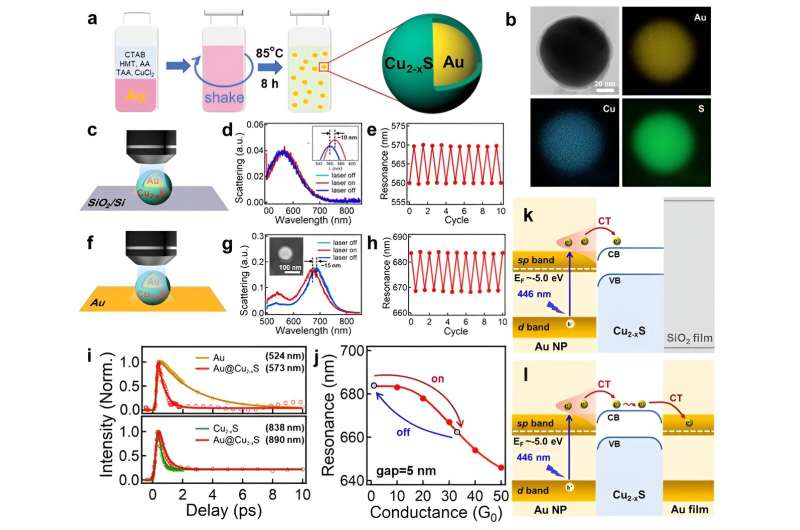Au@Cu2-xS core-shell particles for rapid and reversible control of plasmons and analysis of the mechanism. Credit: Science China Press
Photonic computing, storage, and communication are the foundation for future photonic chips and all-optical neural networks. Nanoscale plasmons, with their ultrafast response speed and ultrasmall mode volume, play an important role in the integration of photonic chips. However, due to the limitations of materials and fundamental principles in many previous systems, they are often incompatible with existing optoelectronics, and their stability and operability are greatly compromised.
A recent report in National Science Review describes research on the dynamic and reversible optical modulation of surface plasmons based on the transport of hot carriers. This research combines the high-speed response of metal nanoplasmons with the optoelectronic modulation of semiconductors.
By optically exciting the hot electrons, it modulates the charge density in gold and the conductivity of the nanogaps, which ultimately renders reversible and ultrafast switching of the plasmon resonances. Thus, it provides an important prototype for optoelectronic switches in nanophotonic chips.
This research was led by the research group of Professor Ding Tao at Wuhan University, in collaboration with Professor Hongxing Xu, Associate Professor Li Zhou and Research Professor Ti Wang, as well as Professor Ququan Wang from the Southern University of Science and Technology.
The research team first prepared Au@Cu2-xS core-shell nanoparticles and characterized their microstructure. The experimental results showed that the sol-gel method can yield Au@Cu2-xS core-shell nanoparticles with different shell thicknesses, providing an ideal carrier for realizing ultrafast dynamic control of nanoscale plasmons. Au@Cu2-xS nanoparticles on different substrates can achieve ultrafast dynamic control of plasmons.
Under laser irradiation, the plasmonic resonance peak of Au@Cu2-xS nanoparticles on the SiO2/Si substrate exhibits a red shift , while the plasmonic resonance peak of Au@Cu2-xS nanoparticles on the Au substrate exhibits a blue shift. When the laser is turned off, the resonance peaks return to their initial positions. All the optoelectronic tuning processes have shown reversibility, controllability, and relatively fast response speeds.
Transient absorption (TA) spectra and theoretic calculations indicate that the optical excitation of the Au@Cu2-xS plasmonic composite structure can cause the hot electrons in Au to transfer to Cu2-xS, leading to a decrease in the electron density of Au and a red shift of the localized surface plasmon resonance (LSPR).
In contrast, when the Au@Cu2-xS is placed on an Au substrate (NPoM structure), the hot electrons can be transported through the Cu2-xS layer to the Au substrate, increasing the conductivity of the nanogap and causing a blue shift of the coupled plasmon polaritons. This plasmonic control strategy based on hot carrier transport is particularly suitable for the integration of optoelectronic devices, providing device prototypes for photonic computing and interconnection.
More information: Jiacheng Yao et al, Optoelectronic tuning of plasmon resonances via optically modulated hot electrons, National Science Review (2023). DOI: 10.1093/nsr/nwad280
Provided by Science China Press
























